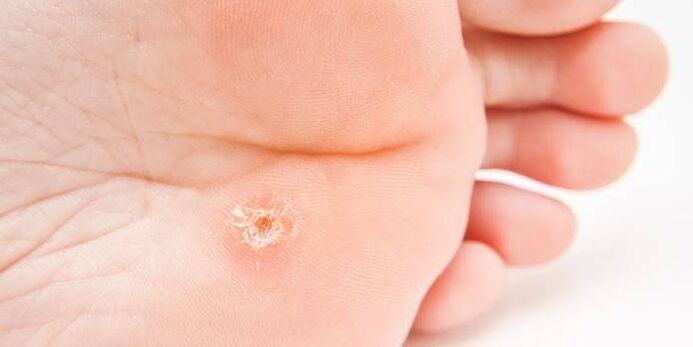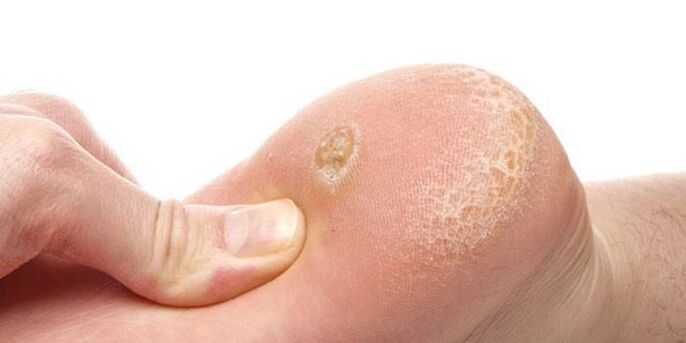From ancient times the ugly formations on the body have plagued mankind. Foot warts are a skin disease caused by a virus. People with skin defects were avoided for fear of infection, and when they noticed a neoplasm on the foot or other part of the body, they tried to remove it as soon as possible. Whatever people do not apply to plantar warts, if only to disappear forever. So far dermatologists are looking for the most effective and painless method of dealing with the disease.
What is a wart
Human papillomavirus provokes a benign or oncological mutation of DNA in skin cells. The body is covered with papillomas, warts, papules. More than a hundred types of HPV have been studied. A wart is a skin growth that indicates the presence of the first or third type of papilloma virus in the body. Neoplasms are not potentially carcinogenic, but are highly contagious due to the viability of the pathogen in the external environment.
What does a wart look like on the feet?
The plantar neoplasm has a round shape with distinct edges a few millimeters or centimeters in size. Black dots of closed capillaries can be seen in the center. On the feet they look like old dry calluses growing on the skin. Plantar growth pain is not manifested by direct pressure but by compression. Characterized by the absence of papillary lines on the feet.

Causes of Plantar Warts
HPV infections are more common during unprotected sex. The virus penetrates the mucous membranes of the genitals through microcracks. Someone's HPV is in "transit", while others are less fortunate - the virus stays in the body for a long time without its messages. Dermatologists do not rule out that the appearance of papillomas on the surface of the feet contributes to immune disorders and infectious diseases.
Walking barefoot in public places: Baths, swimming pools, body care salons, shared bathrooms, on the beach, barefoot shoe testing is the most common cause of plantar warts. The virus is viable beyond its host and "chases prey" on towels, tiles, canvases, furniture, guest slippers and so on. Sh. The infection affects the dense, stretched areas of plantar surfaces and the skin of the wrists, where the papilloma virus enters with minor lesions.
Warts on children's feet
Children are restless, often injured. Parents may not be aware of the presence of HPV in a child's body, which is obtained as a result of wounds and abrasions. With the weakening of immunity, the virus is activated, papilloma appears on the feet. Painful methods of dealing with warts on the feet in children are often contraindicated, poorly tolerated. Often, the baby's body copes with this disease of the skin of the foot on its own.
Types of warts on the feet
Warts are a combination of skin lesions caused by papillomas. The following types of warts are classified based on their external effects on human health:
- Vulgar (normal) - round keratinized blisters;
- Flat - rash in the form of spots on the skin;
- Threaded (acrocords) - with elongated "torn" edges, formed in the folds of the body;
- Genital warts - reminiscent of a cock comb;
- Elderly (keratomas) - Found in the elderly, not related to HPV.
Wart formations are localized all over the body, on internal organs, in the oral cavity. Warts on the feet, called plantar warts, are a common type. One of the types belongs to the well-shaped, which is a depression pressed into the skin, characterized by rapid growth. The appearance of subcutaneous growths slightly elevates the nail plate.

Treatment of plantar warts
It is dangerous to neglect the treatment of plantar warts. Neoplasms in the legs are constantly grazing. They are removed to stop new growths and infections from entering. There is no complete cure for HPV. Treatment is reduced to turning the disease into a "sleep mode". Available medications, surgical, immunomodulatory removal of plantar warts, using alternative medicine.
The disadvantage of treating plantar fasciitis lies in their location: the large corneal layer of the epidermis complicates the delivery of active substances to the depths of the foot formation. In preparation for therapy, the top layer of sediment is soaked and exfoliated. Traditionally, treatment of warts on the feet begins with the use of salicylic acid. The wart is boiled daily in a bath for three months, disinfected, then the softened top layer is cleaned with a pumice stone, salicylic acid is added and a patch is applied.
Pharmacy chains advise how to get rid of warts on the feet with the help of medicines containing celandine, phenol, trichloroacetic acid. Medications cause tissue necrosis, relieving the patient from deficiency but leaving traces of deep wart wound healing. Each disease is individual to varying degrees, so before you choose the method of how to remove a wart at the base of the foot, you should ask your doctor for his opinion.
Ointment
Necrotic, antiviral, herbal ointments are distinguished according to the method of action. In the first case, the acid or alkali present at the base of the ointment enhances the painful growth and leaves a scar. At home, for the treatment of feet, you can use liquid solutions: acetic acid, nitrogen, oxyl, lactic acid. To prevent burns, the surface of the neoplasm is severely treated.
Anti-wart anti-wart ointment is applied to the growth itself and to reduce the growth of infection around it. They are used with special ointments. Herbal ingredients affect only the formation of the skin. Known for their effectiveness in treating foot balm with an applicator, colhamine ointment.
Modern methods of removal
The advent of modern methods of wart removal has replaced the traumatic scalpel. Like a surgeon’s knife, an electrocoagulator burns a leg neoplasm with electricity. Depression remains on the feet after the laser or radiofrequency removal procedure. It takes several weeks to heal. Exposure to liquid nitrogen is considered to be a very painful treatment and requires several treatments. In 2014, British dermatologists published material on the latest antigen injection therapy. It will help patients who are resistant to existing treatments.

Folk remedies
Folk remedies for warts on the feet are carried out at bedtime, with pre-cooked feet and for a long time. Protect your hands from further spread of infection with latex gloves during handling, disinfect all used equipment and items to prevent infection from loved ones. List of effective folk remedies for getting rid of warts:
- Garlic is known for its antibacterial properties. At the base of the neoplasm, dig the upper hardened layer, pour a thin clove of garlic.
- You can make a "beard dough". It is kneaded with finely chopped garlic, vinegar, wheat flour, spread on the surface of the neoplasm and sealed with plaster. After a few days, the dough is removed with the accumulation.
- Put onion soaked in vinegar on your feet, or you can massage the extract with vinegar, then attach fresh onion.
- You can fill the formation with the juice of medicinal plants: celandine, kalanchoe, calendula, dairy plant, dandelion, golden mustache, or attach a slice of apple, mountain ash, figs, potatoes, horseradish, cabbage. The procedure is performed daily, lasting from a few weeks to a month, until the accumulation disappears.
- You can apply wood ash diluted in water in a creamy state.
- The seedlings are sprinkled with chalk powder and wrapped in a bandage. It is impossible to wet the compress.
- Salicylic vodka and willow bark have proven well in treatment. Apply the bark on the feet, pre-softened with boiling water.
- Hot foot baths with sea salt, soda, laundry soap, tea tree oil or spruce broth help to treat foot diseases. Treatment can be mixed or alternating.
- Worm broth applications are used. Boil 3 tablespoons of dry worm grass in a glass of boiling water, boil for at least 2 hours.














































































